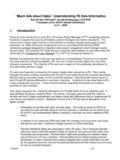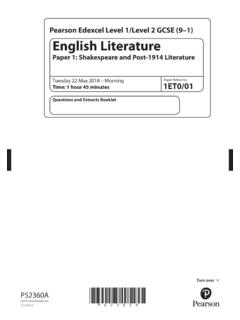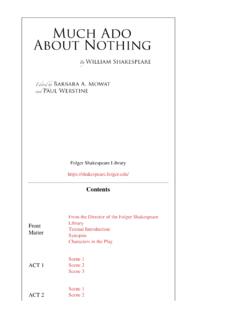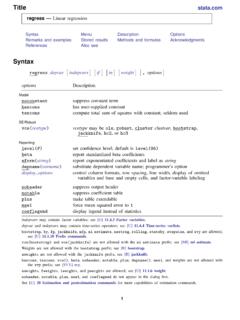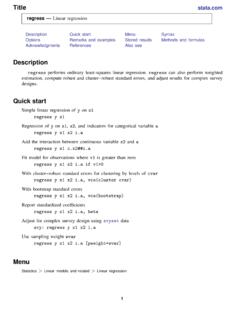Transcription of Learning and Earning Losses from COVID-19 School Closures ...
1 asian development BANKLEARNING AND EARNINGAPRIL 2021 Special Topic of the asian development outlook 2021 Losses FROM COVID-19 School Closures INDEVELOPING ASIAL Earning and Earning Losses from COVID-19 School Closures in developing AsiaCOVID-19 led to prolonged School Closures to varying degrees across developing Asia. These disruptions will affect the skills students acquire and eventually their productivity as future workers. Various distance Learning strategies are being used, but they are only partially effective. Thus, School Closures come at the price of Learning .
2 Learning Losses range from 8% of a Learning -adjusted year of schooling in the Pacific, where schools have mostly stayed open, to 55% in South Asia, where School Closures have been longest. Learning Losses will reduce the future productivity and lifetime earnings of affected students. The present value of these Losses is estimated at $ trillion for developing Asia, equivalent to of the region s 2020 gross domestic product (GDP).Schools closed due to COVID-19 The COVID-19 pandemic led many countries to close schools, in part or in full to help contain the virus.
3 By April 2021, schools had been closed for about 1 year or more in eight of 46 economies in developing Asia. In 11 other economies in the region, schools had been closed for 200 300 days (Figure ). Full School Closures have been longest in Bangladesh and Myanmar; both countries have had over 300 days of government-mandated Closures . In the Philippines, all schools have been closed for more than 200 days. Most economies in developing Asia implemented partial Closures , such as closing schools only in certain regions or for some grade levels and age groups.
4 In some instances, schools have combined reduced class time with distance Learning (UNESCO 2021). Only three economies in developing Asia had not closed schools by April 2021, and in most Pacific economies, schools have been closed for 50 days or section was written by Rhea Molato Gayares of the Economic Research and Regional Cooperation Department (ERCD), ADB, Manila. It benefited from comments from Abdul Abiad, Donald Jay Bertulfo, Elisabetta Gentile, Rana Hasan, Ryotaro Hayashi, Matteo Lanzafame, Yasuyuki Sawada, Milan Thomas, and Paul Vandenberg, and participants at a seminar organized jointly by the asian development Bank s Education Sector Group and ERCD on 17 March 2021.
5 The author is grateful for useful conversations with Jo o Pedro Azevedo from the World Bank, who shared information that helped develop the Special asian development outlook 2021 Figure Number of days schools partially or fully closed, February 2020 to April 2021 Partially closedFully closed Number of daysEast AsiaCentral AsiaSoutheast AsiaThe PacificSouth AsiaArmeniaAzerbaijanGeorgiaKazakhstanKy rgyz RepublicTajikistanTurkmenistanUzbekistan Hong Kong ChinaMongoliaRepublic of KoreaTaipei ChinaAfghanistanBangladeshBhutanMaldives NepalPakistanSri LankaBrunei DarussalamCambodiaIndonesiaLao PDRM alaysiaMyanmarPhilippinesSingaporeThaila ndTimor-LesteViet NamCook IslandsKiribatiMarshall IslandsNauruPalauPapua New GuineaSamoaSolomon IslandsTongaTuvaluVanuatuFSMFijiNiuePRCI ndiaFSM =
6 Federated States of Micronesia, Lao PDR = Lao People s Democratic Republic, PRC = People s Republic of : UNESCO COVID-19 Response. (accessed 30 March 2021); for Hong Kong, China and Taipei,China, Oxford COVID-19 Government Response Tracker. (accessed 14 April 2021). School Closures mean students lose opportunities to learn vital cognitive, social, physical, and emotional skills. Students also tend to forget part of what they have learned when they take a break from School (Cooper et al. 1996). From a life-cycle perspective, the skills that children learn at a younger age set the stage for acquiring more advanced skills as they get older.
7 When young students miss out on opportunities to learn these skills, the total skill level that they acquire in their lifetime is at risk of being lower (Meyers and Thomasson 2017; Gibbs et al. 2019; Andrabi, Daniels, and Das 2020). For this reason, this analysis focuses on students at the preprimary, primary, and secondary levels of Learning strategies usedEconomies all over the world have used alternative Learning options to make up for lost School days. A UNESCO, UNICEF, and World Bank survey of education ministry officials conducted from April to October 2020 shows that online and television platforms have been the predominant modes of instruction in economies in developing Asia during the COVID-19 pandemic (Table ).
8 Online platforms include government websites that provide Learning content and video Asia remains resilient, amid divergent recovery paths 3 Table Remote Learning modesSubregionEconomySurvey monthOnline platformsTelevisionRadioTake-home packagesCentral AsiaArmeniaAugust AzerbaijanSeptember GeorgiaAugust KazakhstanApril, May, or June Kyrgyz RepublicSeptember UzbekistanAugust East AsiaHong Kong, ChinaSeptember MongoliaJuly PRCS eptember Republic of KoreaOctober South AsiaAfghanistanAugust BangladeshApril, May, or June BhutanAugust IndiaApril, May, or June MaldivesAugust NepalAugust PakistanOctober Sri LankaAugust Southeast AsiaCambodiaSeptember IndonesiaApril, May, or June Lao PDRJuly MalaysiaApril, May, or June MyanmarApril, May, or June PhilippinesApril, May, or June SingaporeAugust ThailandJuly Timor-LesteApril, May, or June Viet NamJuly The PacificCook IslandsJuly FijiApril, May, or June KiribatiApril, May, or June NiueApril, May, or June PalauApril, May, or June Papua New GuineaApril, May.
9 Or June SamoaOctober Solomon IslandsAugust To n g aJuly TuvaluAugust VanuatuAugust Lao PDR = Lao People s Democratic Republic, PRC = People s Republic of : UNESCO, UNICEF, and World Bank. 2020. Survey on National Education Responses to COVID-19 School Closures , Round 1 (April June) and Round 2 (July October). (accessed 13 April 2021). 4 asian development outlook 2021conferencing platforms, such as Zoom and Google Meet. Some video lessons are also delivered via YouTube. Social media facilitates communication. Educational television programs are being made by both governments and the private sector.
10 Another common practice is to distribute paper-based Learning modules and worksheets as a complement or substitute for students who have no access to television or the day-to-day operations of distance Learning are largely the responsibility of teachers and parents or caregivers, who do the teaching and monitor progress. The sudden closure of schools because of the COVID-19 pandemic left teachers and parents with little time to prepare for home schooling. Teachers in the economies of developing Asia were provided support in the form of special training, instructions on remote Learning , and, in some cases, information and communication technology tools and free connectivity (UNESCO, UNICEF, and World Bank 2020a).










